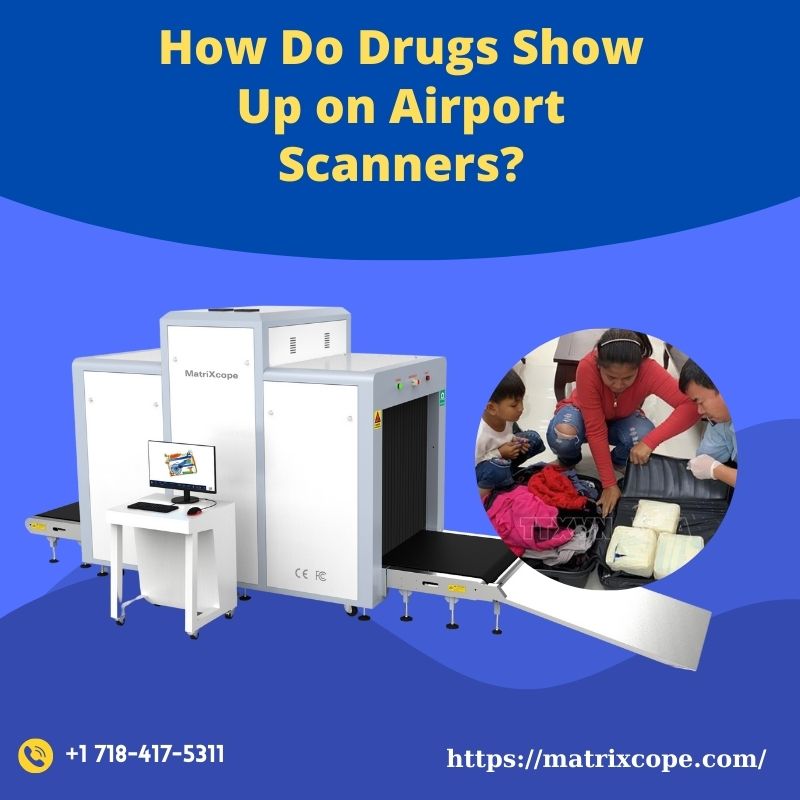Blogs
How Do Drugs Show Up on Airport Scanners?
When traveling, one of the most important aspects of airport security is detecting prohibited items, including illegal drugs. Many travelers wonder, “How do drugs show up on airport scanners?” Understanding the technology behind airport scanners and their ability to detect hidden substances can shed light on how security personnel keep our skies safe. This article with Matrixscope explores how they detect drugs and the procedures taken when suspicious items are flagged, providing insight into the sophisticated methods used to combat drug smuggling.

Types of Airport Scanners Used for Drug Detection
There are various types of scanners used in airports, each designed for a specific purpose. The two primary types include:
X-ray Scanners: Used for screening baggage, X-ray scanners can detect objects with different densities, including drugs hidden in luggage. Organic materials, such as drugs, appear differently on X-ray images compared to metal or plastic.
Millimeter-Wave Scanners: These full-body scanners detect items concealed on a person’s body. Drugs hidden in clothing or strapped to the body are visible to these scanners because they can detect unusual shapes or densities that stand out against the natural contours of the human body.
What Airport Scanners Look For
Airport scanners don’t specifically “look” for drugs. Instead, they identify abnormalities or suspicious items based on density, shape, and the material’s composition.
Density Anomalies: Drugs, especially when compressed, may show up as dense, opaque masses on scanners. The scanner’s software will flag any dense material that doesn’t match the expected density of normal items, such as clothing or typical travel items.
Unusual Packaging: If drugs are concealed in irregular packaging—such as within electronics or hollowed-out items—they can stand out during an X-ray scan. Airport scanners can easily spot irregularities in shapes and layers.
Organic Detection: Drugs made from organic compounds—like heroin, cocaine, or marijuana—often have distinct signatures. While scanners can’t specifically identify drugs just from an image, trained security officers will investigate suspicious organic material further.
How Security Officers Identify Drugs
Once an item or anomaly is flagged by a scanner, it is the job of trained security officers to examine it further. This often involves:
Manual Searches: When an anomaly is detected in a bag or on a person’s body, a manual search may be conducted. Officers will physically inspect the item to see if it contains illicit substances.
Drug Detection Dogs: Trained canines are often used to sniff out drugs, providing an extra layer of detection at airports.
Chemical Testing: If something suspicious is found, a small sample may be taken for immediate testing using portable chemical detection kits. These kits can identify various substances, including drugs.
Common Methods People Use to Smuggle Drugs Through Airports
Despite the advanced technology used by airport scanners, some smugglers attempt creative ways to get drugs through. Common methods include:
Swallowing or Inserting Drugs: Smugglers sometimes ingest drug-filled capsules or hide them within body cavities. However, body scanners and X-ray machines can often detect these objects because they differ in density from normal tissues.
Hiding in Everyday Objects: Another popular method is concealing drugs in everyday items, such as books, shoes, or electronics. While this may work against less sophisticated screening methods, modern airport scanners can usually detect these hidden compartments.
False Lining in Bags: Adding a false bottom or secret compartment in luggage might seem like a clever trick, but X-ray scanners will typically catch the irregularities, flagging the item for further inspection.
In conclusion, when examining how drugs appear on airport scanners, the role of advanced detection technologies like the Matrixcope is crucial. These scanners utilize a combination of X-rays, millimeter-wave, and computed tomography (CT) to detect anomalies in luggage or on individuals. Drugs can be identified based on their density, composition, and packaging, with scanners highlighting objects that deviate from the norm. The Matrixcope, with its cutting-edge imaging capabilities, enhances this process by offering clearer, more detailed visuals, helping security personnel identify potential threats efficiently while maintaining safety at airports.
